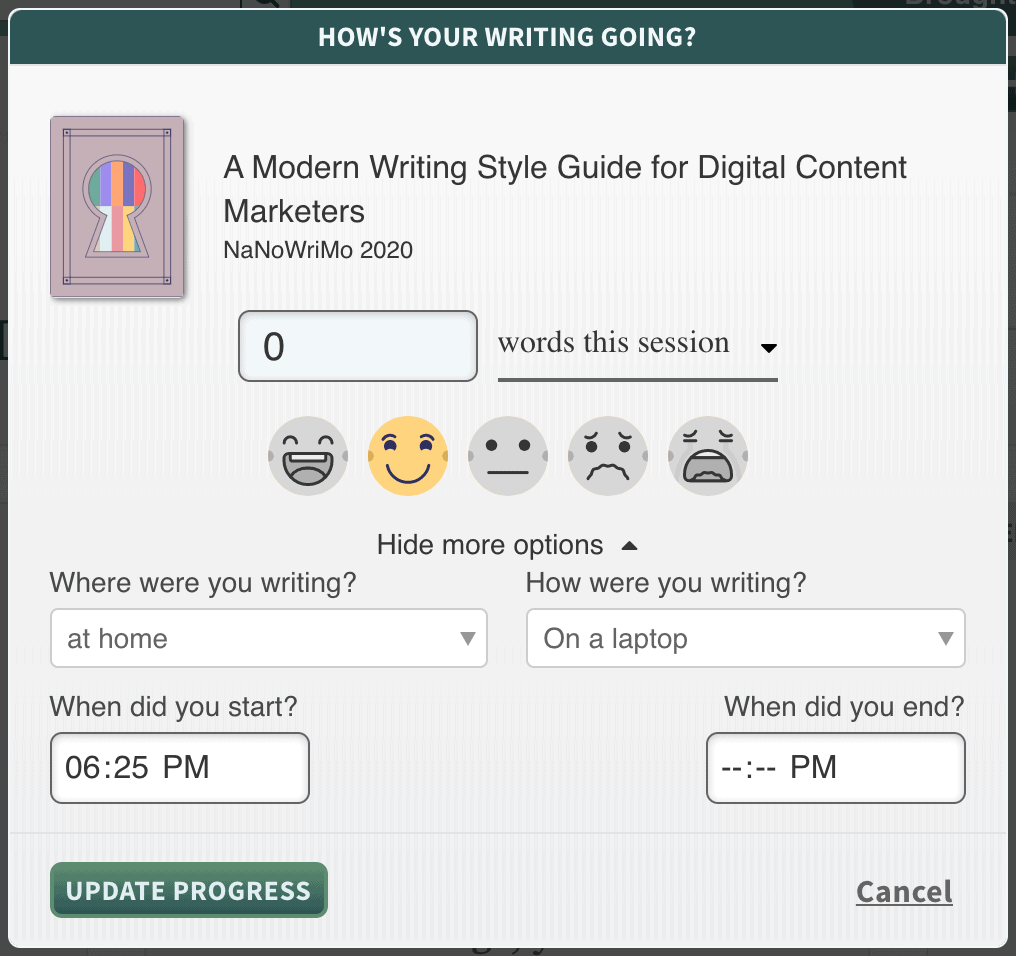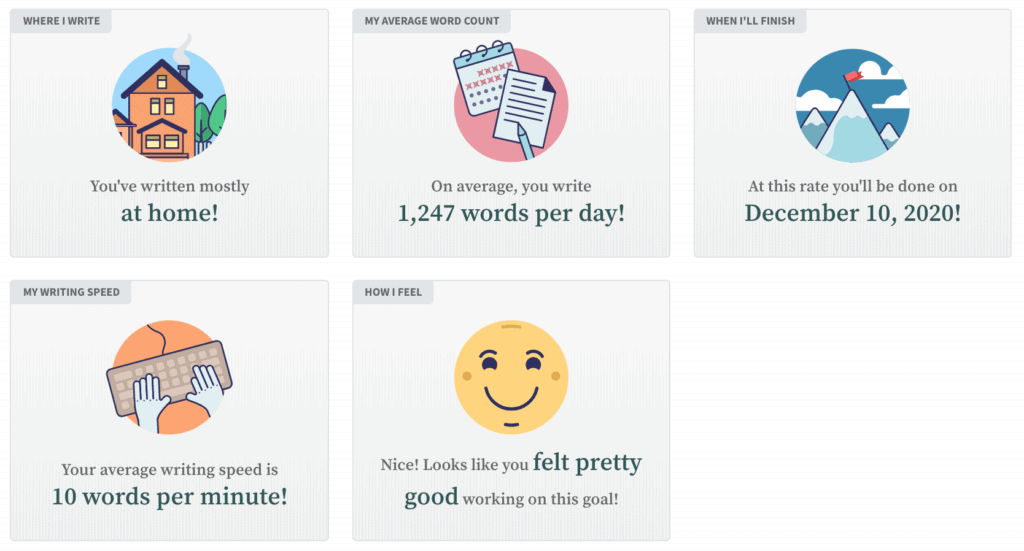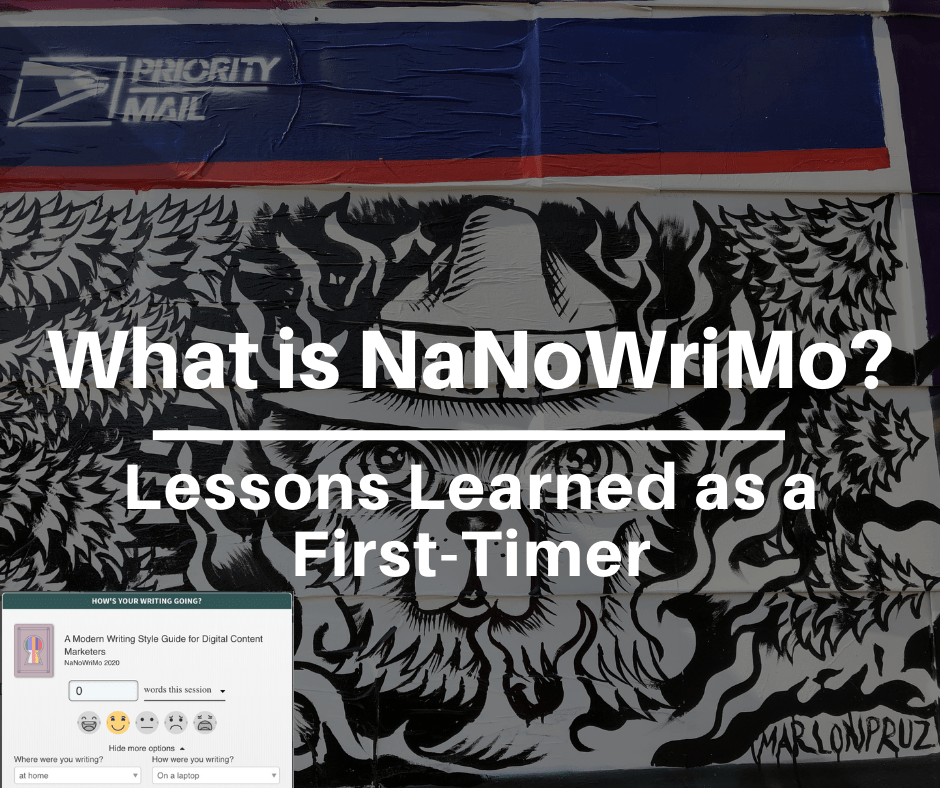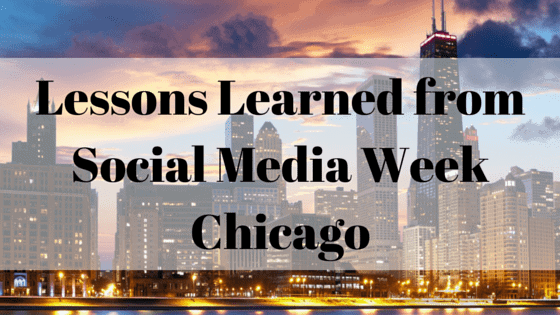Please note: this article contains affiliate links for products I use.
I’d been thinking about participating in NaNoWriMo for years before I finally gave it a try.
While writing this article, I searched the term “NaNoWriMo” in my Google Drive and was surprised to come across a Doc from 2016 — a list of goals. One of my goals for that year was to participate in NaNoWriMo.
Alas, it was not meant to be that year, which was one of my first years of freelancing full-time and meant full-time hustle. But the goal stuck with me until finally participating for the first time in November 2020.
Here’s what I learned:
What is NaNoWriMo?
NaNoWriMo stands for “National Novel Writing Month.” People from all over the world commit to an end goal of having written 50,000 words by the end of the month. Although most participants are writing fiction, there are no rules that define the specific terms of what you write. The point is to set a goal and achieve it — or at least get some basic writing done!
When is NaNoWriMo?
NaNoWriMo consistently takes place every year throughout the month of November. There are other related events that happen throughout the year, such as Camp NaNoWriMo.
Camp NaNoWriMo is a flexible writing event that takes place in April and July. Word count goals are customizable and can be converted to different units, such as hours, lines, pages, or minutes. With this flexibility in mind, some writers use it as an opportunity to edit the novel they wrote during NaNoWriMo instead of writing something new.
NaNoWriMo: How Many Words a Day?
Writing 50,000 words in November means roughly 1,666 words per day, on average. Daily participation in NaNoWriMo involves signing into their free platform and logging an entry. You can specify your mood, where you did your writing, your specific writing medium, and the time period.

It’s worth it to take the time to add these specifics, because NaNoWriMo’s software tracks patterns over time that can give you insights into your productivity and progress towards the ultimate goal.


How do You Win NaNoWriMo?
If you write 50,000 words in November, you’ll “win” NaNoWriMo. Winning NaNoWriMo just means that you’ve achieved the word count goal.
Keep in mind that the goal is not to end with the perfect end product. Try to restrain yourself from editing your work while you’re writing it and it’ll be much easier to achieve the 50,000 word end goal.
And it’s as simple as that! NaNoWriMo isn’t complicated — the hard part is showing up and pushing through even when you don’t really feel like it.
My 2020 NaNoWriMo Goal
I don’t know if my writing skills will ever translate to creating works of fiction but perhaps someday I will challenge myself. This year, I set forth to write a non-fiction business book.
With the working title of A Modern Writing Style Guide, I’m writing this book for two reasons:
- The people who work for me would benefit from it.
- Other people might appreciate some thoughts on style as it applies to web content.
The book is an extension of my company’s writing style guide. It’s an important tool for creating consistent, high-quality content for clients. At publication, it’s 13 pages long — not exactly a short read!
The more I work with different writers and editors, the more I realize that without being extremely clear with your expectations, there’s a lot of room for interpretation. The less rigidly you define rules, the more varied the responses you’ll get. And you don’t want too much variation when working with clients. There must be some level of standardized style to work off of.
If someone’s interpreting your style rule in a way you didn’t intend but didn’t explicitly define, you can’t get mad at them. You need to accept responsibility for setting expectations and continuously improving your instruction.
So this book is my attempt to add a new layer of understanding on top of the streamlined version of my style guide. This book seeks to update basic rules with more detailed examples and use cases. In many ways, it’s inspired by the timeless Elements of Style — but tailored to digital communications and content.
Planning for NaNoWriMo 2020
I’d been thinking about doing NaNoWriMo in the back of my head all year but it didn’t get real in terms of planning until a month or so before November 2020.
But once I was ready, I started brainstorming. I didn’t want to go after this goal without a plan. To have enough to write 50,000 words, I needed to be prepared with plenty of topic ideas to flesh out chapters.
As it turned out, I probably pre-planned only about half of the topics that I needed to hit the end word count. Of course, hindsight is 2020 when going into a situation you have no personal experience with.
So I looked through my existing style guide and defined chapters for each major section. Then I thought of other subsections I could add to flesh out each chapter. I also thought about sections of my style guide that are currently lacking and that I’ve noticed could benefit from additional explanation.
Truly, I had a lot to work with.
And that was it. I defined the sections and subsections, plus some links to reference material (including much of my own previous content creations) — but didn’t go as far actually outlining material. Part of me wishes I had done a little bit of that but I don’t know that it would’ve been worth all the prep. I wanted the majority of the work to happen within the month of November.
The Average Writing Session During NaNoWriMo
Each day in November, most often at night after work, I spent 2+ hours working on my NaNoWriMo goals. I also tended to write in the living room, with my laptop, versus where I do most of my work, on my desktop computer in my office.
I ended up giving myself a weekend day off here and there and faltered a bit with consistency at the end. There were some days where I was only able to knock out 500 words. But for the most part, I pushed ahead with daily progress.
I started the month by picking the topics I was most interested in focusing on that day. After a while, I had to work through the less interesting topics as they were important to the end goal of fleshing out every section of my style guide.
I’m glad that I had the end goal of NaNoWriMo to push me forward while working on the more boring (but necessary) sections.
Most sessions consisted of using my style guide as an outline, refining my original language and fleshing things out. Occasionally, I’d consult the AP Stylebook to either state their rule and why I agreed with it or why I had an exception to it when it comes to web content.
Tired but committed: inching very close to 15,000 words for #NaNoWriMo! Today, I finished my general style guidelines section and fleshed out a section about word choice. It's making me think critically about each guideline I'm including and expanding on. pic.twitter.com/lmxq9HZn3G
— Maddy Osman (@MaddyOsman) November 12, 2020
And throughout NaNoWriMo, I didn’t fully finish every section — some still more examples. I wanted to focus on getting stuff done, not getting tripped up by the details.
That’s a good mindset for working on blog content, too. Done is better than perfect. And a skeleton with some missing pieces is a whole lot better than absolutely nothing.
The thing is, you’re never going to do your best work in just one day. Even if you’re writing a short piece, ideally, you’re splitting up outlining, drafting, and editing stages across multiple days. You need to give your brain time to process the topic from different perspectives for it to turn out the best it can.
Some days, I wrote with a playlist in the background. During some sessions, there was no noise. Most sessions I had some trash TV playing in the background — just like when I write blog posts.
The Importance of Accountability
There are NaNoWriMo communities all over the web, including on the platform itself. NaNoWriMo attempts to connect writers with other participants in their local communities.
In normal times, these local connections would make for some great in-person accountability groups to get shit done. Of course, this year, virtual is really the only way to go. Many NaNoWriMo participants swear by write-ins where they check in with and share progress with other participants over chat.
I can’t say that I got too deeply enmeshed in any NaNoWriMo communities. I felt like somewhat of an outsider as it was my first year. And my initial attempts at outreach with the built-in community didn’t result in much of anything.
But I did turn to my family, friends, therapist, and mastermind groups to share my progress. I also tweeted a summary of what I did almost every day to hold myself accountable to my audience.
This accountability system worked out well enough for me but I’d love to do some in-person events if possible next year.
The Last Days of NaNoWriMo
So if you’ve read this far, you’re probably wondering — did I actually achieve my goal?
Here’s what happened by the end of NaNoWriMo:
I let my word count drop below the minimum for multiple days during the month with several days that didn’t result in any progress. I started the month strong but found myself with a lot to make up for at the end of the month in order to achieve the ultimate goal of 50,000 words.
I had a resurgence of super high word count days as the deadline loomed near, but also days where I felt like I couldn’t hit the minimum even during the final stretch. By the end of the month, I crept closer towards being on track.
Overall, I was consistent in making progress almost every day of the month. There were four days that I didn’t write anything, but that felt like a necessary break from hitting it hard the rest of the month. Of course, giving myself planned days off also added 1666 words per day that I had to make up for on other days.
Today was not a great day for my #NaNoWriMo goals. I didn't hit the minimum word count, but I made some progress by focusing on a section about guidelines for incorporating visuals in written content. I hope that tomorrow brings some relief and focus. pic.twitter.com/K0CW9NqOoJ
— Maddy Osman (@MaddyOsman) November 5, 2020
At any rate, here’s the good news:
I won my first NaNoWriMo!
I had ~3,500 words to knock out on the last day of the month, with several ideas for what to write about. It was a work day for me, so I had to split my attention, but I was able to make it happen. That tracks well with the way I work in general — I need the pressure of deadlines to force me to get stuff done.
By the end of NaNoWriMo 2020, I came out with a rough draft for my book and 10 long-form blog posts for The Blogsmith that I’ve been wanting to write for a while.
I couldn’t be more pleased with the end result.
I WON #NaNoWriMo2020! 🎉🎉
— Maddy Osman (@MaddyOsman) December 1, 2020
With my 50,000 words completed, I now have a great rough draft for The Blogsmith's extended and super detailed style guide for web content *AND* 10 long-form blog posts for The Blogsmith's website.
I'm so glad I participated! pic.twitter.com/qBvmHFxiom
Looking Towards NaNoWriMo 2021
Would I do it again? Absolutely. I knew that even before I achieved the 50,000 word end goal.
At the end of this year’s event, I honestly ran out of topics to include in my style guide.
I had expanded my initial list of topics with some extra ideas that I picked up while doing research and considering improvements to my style guide. But eventually, I ran out of things to say about these additional topics. It didn’t feel right to force the word count just because of the specific number decreed by the creators of NaNoWriMo.
Hit the 20,000 word count today for #NaNoWriMo!
— Maddy Osman (@MaddyOsman) November 16, 2020
Today, I fleshed out an outline I started for a fact-checking section, a section about developing your own style guide (with tons of awesome brand examples), and a section about auditing content effectiveness. pic.twitter.com/9LPPW4TVDU
But I also didn’t want to quit the challenge early without trying to hit that end goal.
So I made a compromise:
Instead of continuing to flesh out the style guide past its prime structure, I started working on blog content I’d been meaning to write or that was tangentially related to my style guide subject.
Now that I’ve seen how many topics I could knock out and how good it felt to pay attention to my own blog’s editorial calendar again, I think that next year I want to focus all of NaNoWriMo on writing blog content for The Blogsmith.
I passed the 30k word count milestone today for #NaNoWriMo. I'm working on blog post topics that somewhat relate to my book topic — today's is a guest post about my agency content workflow.
— Maddy Osman (@MaddyOsman) November 25, 2020
I'm ~9k words behind target and it's crunch time! pic.twitter.com/KzE1MXi046
Can you imagine how nice it would be to knock out a year’s worth of content in one month? I’m here for that.
For next year, my NaNoWriMo prep will involve identifying and creating a (very) basic outline for each blog post I want to knock out. I’ll probably go further than that to do some keyword research and plan out the resulting editorial calendar based on trying to cover a range of things customers would want to read.
Final Thoughts: What is NaNoWriMo? Lessons Learned as a First-Timer
One of my biggest takeaways is that NaNoWriMo isn’t hard because writing is hard. Honestly, anyone could do it. You could do it to start a blog about a topic that excites you or even write a memoir about yourself or a member of your family.
What’s really hard is being consistent and putting in a not-insignificant amount of time each day to chip away at the overwhelming goal of 50,000 words in a month.
During the 2020 pandemic, it was probably necessary for my mental health to have a goal to chip away at. Sometimes during the month, getting in my daily writing time was the only productive thing I did that day. Working towards this goal kept me motivated to get up each day and give it a try.
At any rate, I’m so glad that I finally achieved a goal I’ve had since at least 2016 — participating in and winning NaNoWriMo. It felt good to dig deep into a topic I’ve been thinking a lot about and to write for the joy of it. As much as I love my clients, it’s just a different mental state to create content for your own purposes.
Although I’m looking forward to a short break from planned daily writing sessions, I can’t wait to do it all over again during NaNoWriMo 2021!
Now that you know the answer to the question, “What is NaNoWriMo?,” what questions do you have about what it’s like to participate in NaNoWriMo? Are you planning a project for the next event? Tell me all about it in the comments.










